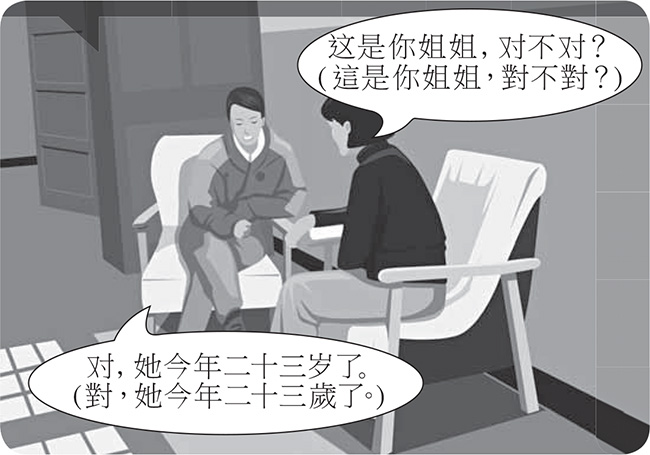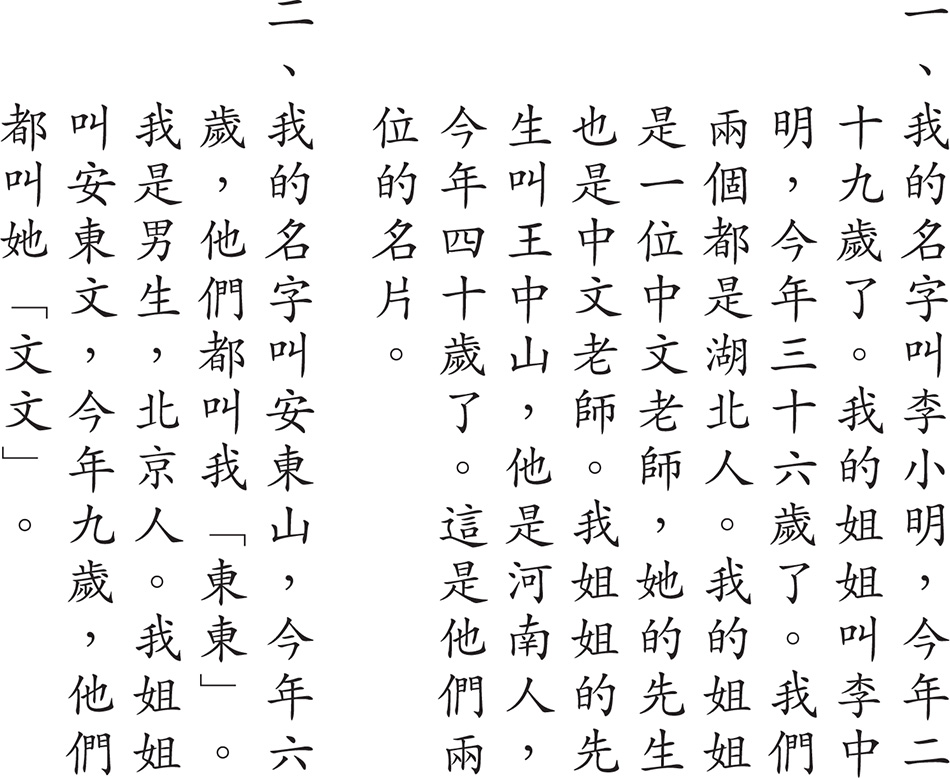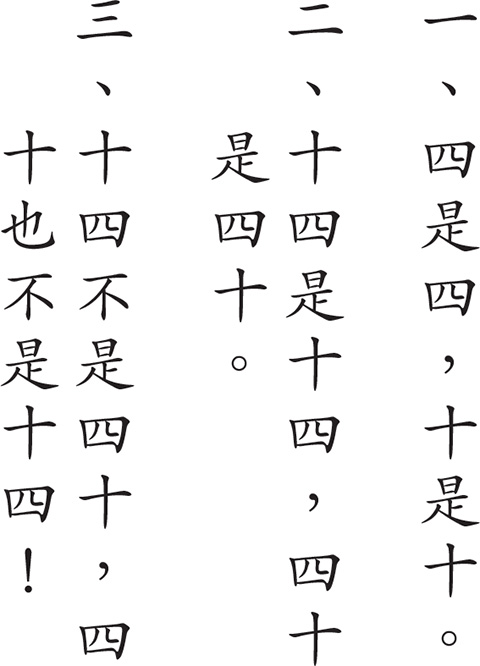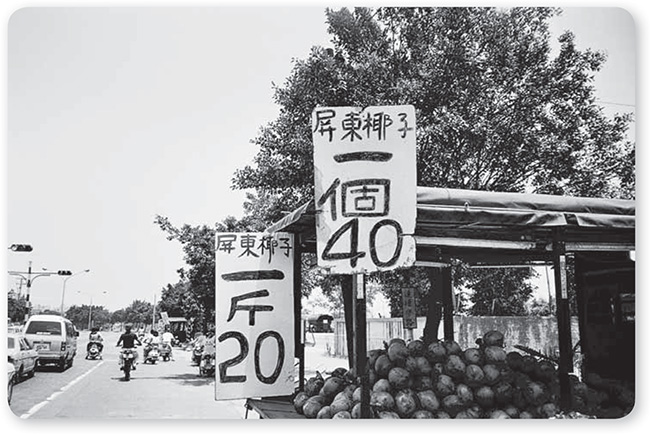PART 2
Inquiring About Age

New Characters and Words 
Study the six characters below and the common words written with them, paying careful attention to each character’s pronunciation, meaning, and structure, as well as similar-looking characters. After you’ve studied a character, turn to the Practice Book volume and practice writing it on the practice sheet, making sure to follow the correct stroke order and direction as you pronounce it out loud and think of its meaning.
103 |
多 |
duō |
much, many, more; how |
Radical is 夕 xī “evening” [BF]. The repetition of 夕 in 多 suggests the meaning of “many.” Contrast 多 with 名 míng (83). In the sense of “how,” the official pronunciation of 多 is duō in mainland China but duó in Taiwan. |
|||
多 |
duō/duó |
how [QW] |
|
多大 |
duō dà/duó dà |
how old? |
|
104 |
年 |
nián |
year |
Radical is 干 gān “shield” [BF]. Contrast 年 with 生 shēng (22). |
|||
年 |
Nián |
Nian [SN] |
|
105 |
纪(紀) |
jì |
to record |
Radical is 丝 ( 絲 ) sī “silk.” When at the left side of a character, this radical is referred to colloquially as 绞丝旁 ( 絞絲旁 ) jiăosīpáng “side made up of twisted silk” and is written as 纟 (糹). Phonetic is 己 jĭ “self” [BF]. |
|||
年纪 (年紀 ) |
niánji |
age [N] |
|
多大年纪 (多大年紀) |
duō dà niánji |
how many years old? |
|
106 |
今 |
jīn |
now |
Radical is 人 rén “person,” which is here written with its two legs spread out across the top of the character and known as 人字头 ( 人字頭 ) rénzìtóu “top made up of the character 人.” Contrast 今 with 公 gōng (94). |
|||
今年 |
jīnnián |
this year [TW] |
|
107 |
岁(歲) |
suì |
year of age |
Radical of the simplified form is 山 shān “mountain” (14). Radical of the traditional form is 止 zhĭ “stop” [BF]. |
|||
岁 (歲) |
suì |
year of age [M] |
|
几岁 (幾歲) |
jĭsuì |
how many years old? (of a child) |
|
八岁 (八歲) |
bāsuì |
eight years old |
|
108 |
对(對) |
duì |
correct |
Radical is 寸 cùn “inch.” The other component in the simplified form is 又 yòu “again” (210). |
|||
对 (對) |
duì |
be correct [SV] |
|
对不对 (對不對) |
duì bu dui |
correct or not correct, “right?” |
|
New Words in BMC–SL 3-2 Written with Characters You Already Know 
大 |
dà |
be big; old (of people) [SV] |
姐姐 |
jiĕjie |
older sister [N] |
上 |
shàng- |
last [SP] |
Reading Exercises (Simplified Characters) 
Now practice reading the new characters and words for this lesson in context in sentences, conversations, and narratives. Be sure to refer to the Notes at the end of this lesson, and make use of the accompanying audio disc to hear and practice correct pronunciation, phrasing, and intonation.
A. NUMBERS AND AGES
Read out loud each of the following numbers or age expressions, making sure to think carefully of the meaning of what you’re reading.
1. 三十五
2. 六十八
3. 九十二
4. 四十
5. 七十五
6. 八十三
7. 二十一
8. 三十
9. 五十六
10. 十九
11. 四十五岁
12. 七十一岁
13. 五十七岁
14. 十四岁
15. 四十岁
16. 十二岁
17. 两岁
18. 九十九岁
19. 十八岁
20. 二十二岁
B. SENTENCES
Read out loud each of the following sentences, which include all the new characters of this lesson. The first time you read a sentence, focus special attention on the characters and words that are new to you, reminding yourself of their pronunciation and meaning. The second time, aim to comprehend the overall meaning of the sentence.
一、这是你的姐姐吗?她今年多大年纪了?
二、我姐姐的先生是美国人,他的中文很好,他是中文老师。
三、我的名字叫司小文,今年十九岁,我姐姐叫司文香。
四、你几岁了?五岁了,对不对?
五、你的同屋是中国人吧?他今年多大了?二十岁,对不对?
六、李老师的两个姐姐也都是老师,对不对?她们的年纪都不小了吧?
七、我们今年的中文老师是上海人,不是吗?
八、这个公司的人都是男的吗?这是不对的!
九、小何的两位老师都是美国人,年纪都不大。
十、王大海的两位中文老师年纪都很大,一位八十岁,一位七十五岁。
C. CONVERSATIONS
Read out loud the following conversations, including the name or role of the person speaking. If possible, find a partner or partners and each of you play a role. Then switch roles, so you get practice reading all of the lines.
一、
老先生:老太太,您多大年纪了?
老太太:我年纪不小了,今年八十三岁了。老先生,您呢?
老先生:我今年八十四岁了!
二、
高金美小姐:香香,你多大了?
林文香小姐:我三十岁了。老了!
高金美小姐:不老,不老。我姐姐四十五岁了,她也不老。
三、
李太太:谢太太,这是您的姐姐,对吧?
谢太太:不是!我姐姐五十岁,这位老太太八十岁了!
四、
大海:你多大年纪了?
文山:我二十一岁了。你呢?你多大了?
大海:请你别问,好不好!
D. CHARACTER DIFFERENTIATION DRILLS
Distinguish carefully the following similar-looking characters, pronouncing each one out loud and thinking of its meaning.
一、多 多 多 名 名 名
二、多 名 名 多 多 名 多
三、今 今 今 公 公 公
四、今 公 公 今 公 公 今
五、年 年 年 生 生 生
六、年 生 年 年 生 生 年
E. NARRATIVES
Read the following narratives, paying special attention to punctuation and overall structure. The first time you read a narrative, read it out loud; the second time, read silently and try to gradually increase your reading speed. Always think of the meaning of what you’re reading.
一、 |
我的名字叫李小明,今年二十九岁了。我的姐姐叫李中明,今年三十六岁了。我们两个都是湖北人。我的姐姐是一位中文老师,她的先生也是中文老师。我姐姐的先生叫王中山,他是河南人,今年四十岁了。这是他们两位的名片。 |
二、 |
我的名字叫安东山,今年六岁,他们都叫我“东东”。我是男生,北京人。我姐姐叫安东文,今年九岁,他们都叫她“文文”。 |
F. SUPPLEMENT: A TONGUE TWISTER
Read out loud each of the lines of the following Chinese tongue twister. When you’ve read each line separately, say all three lines together as fast as you can!
一、四是四,十是十。
二、十四是十四,四十是四十。
三、十四不是四十,四十也不是十四!
Reading Exercises (Traditional Characters) 
A. NUMBERS AND AGES
Read out loud each of the following numbers or age expressions, making sure to think carefully of the meaning of what you’re reading.

B. SENTENCES
Read out loud each of the following sentences, which include all the new characters of this lesson. The first time you read a sentence, focus special attention on the characters and words that are new to you, reminding yourself of their pronunciation and meaning. The second time, aim to comprehend the overall meaning of the sentence.

C. CONVERSATIONS
Read out loud the following conversations, including the name or role of the person speaking. If possible, find a partner or partners and each of you play a role. Then switch roles, so you get practice reading all of the lines.

D. CHARACTER DIFFERENTIATION DRILLS
Distinguish carefully the following similar-looking characters, pronouncing each one out loud and thinking of its meaning.

E. NARRATIVES
Read the following narratives, paying special attention to punctuation and overall structure. The first time you read a narrative, read it out loud; the second time, read silently and try to gradually increase your reading speed. Always think of the meaning of what you’re reading.

F. SUPPLEMENT: A TONGUE TWISTER
Read out loud each of the lines of the following Chinese tongue twister. When you’ve read each line separately, say all three lines together as fast as you can!

Notes
B6. 她们的年纪都不小了吧?(她們的年紀都不小了吧?) literally means “Their age is not small, I suppose?” In good English, we could translate as “I guess they’re not so young, huh?” or “I guess they must be rather old?”
B7. In the question 我们今年的中文老师是上海人,不是吗?(我們今年的中文老師是上海人,不是嗎?), the tag question 不是吗 (不是嗎) literally means “is it not so?” In smoother English, we could translate the whole question as “Our Chinese teacher this year is from Shanghai, right?”
B8. In this sentence, 这是不对的!(這是不對的!) means “This isn’t right!” (in the sense of “This isn’t as it should be!”).
B9. In this sentence, 年纪都不大 (年紀都不大) literally means “age both not big.” In better English, we could translate “neither of them is very old” or “both of them are rather young.”
C1. Note that in Chinese, addressing an elderly woman as 老太太, lit. “old lady,” is considered quite polite and respectful, not at all rude as it would be in English.
C3. The context for this conversation is as follows: the first speaker is looking at several photographs and is guessing who the person in the photograph might be. The second speaker comments on the accuracy of the first speaker’s guess.
E1. In the sentence 这是他们两位的名片 (這是他們兩位的名片), the pronoun 这 (這) means “these” rather than “this.” How do we know this? From the context, because it would not make sense to interpret the sentence as “This is the name card of the two of them,” since two people would not normally share one name card.
F. This tongue twister would be especially challenging for the hundreds of millions of native Chinese speakers who have non-standard Mandarin pronunciation and pronounce sh- as s-.

Stand in southern Taiwan selling coconuts